7.2 Setting the Boundaries: Limiting Factors
Discuss factors that limit the geographic ranges of organisms.
Aside from humans, no single species lives everywhere, and for good reason: No single species can adapt to the wide range of environmental extremes found across Earth’s surface. All species have an ecological niche, which consists of the resources and environmental conditions that the species requires. A niche can be thought of as a species’ job or way of obtaining food. Niches exist within habitat, the physical environment in which a species lives.
niche
The resources and environmental conditions that a species requires.
habitat
The physical environment in which an organism lives.
Species with narrow ecological niches are called specialists. Species with broad niches are called generalists. The peregrine falcon (Falco peregrines), for example, is a generalist found on every continent (Figure 7.8A). It is therefore said to have a cosmopolitan geographic range. The yellow-
endemic
Restricted to one geographic area.
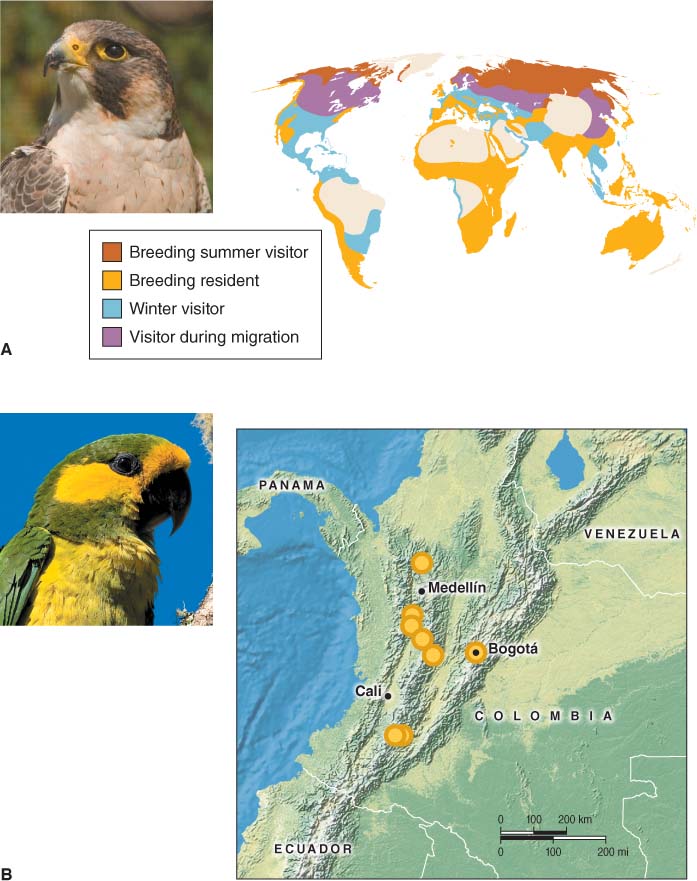
Why is it that the peregrine falcon is found worldwide, but the yellow-
The geographically restricted yellow-
Generally speaking, the narrower a species’ niche is, the more limiting factors will be operating to restrict its geographic range. A limiting factor is any factor that prevents an organism from reaching its reproductive or geographic potential. For example, too little water can limit the growth of plants. Similarly, too much water can limit the growth of, or even kill, drought-
limiting factor
Any factor that prevents an organism from reaching its reproductive or geographic potential.
Limiting factors result in stress for an organism and lower reproductive success. Reproductive success is important because it is the foundation of any species’ long-
extinction
The permanent and global loss of a species.
Physical Limiting Factors
Limiting factors can be divided into two groups, physical limiting factors and biological limiting factors. Six major limiting factors are shown in Table 7.1, but many others exist that are not discussed here.
|
PHYSICAL LIMITING FACTORS |
BIOLOGICAL LIMITING FACTORS |
|---|---|
|
Light |
Predation |
|
Temperature |
Competition |
|
Water |
Mutualism |
Light
Some plants cannot grow in full sunlight or full shade, while others can tolerate a wide range of light conditions. Many plants can be categorized as either light-

Temperature
Temperature strongly controls the geographic ranges of plants. Extreme high or low temperatures lead to reduced photosynthesis and mortality in plants. Animals are also limited by temperature (Figure 7.10).
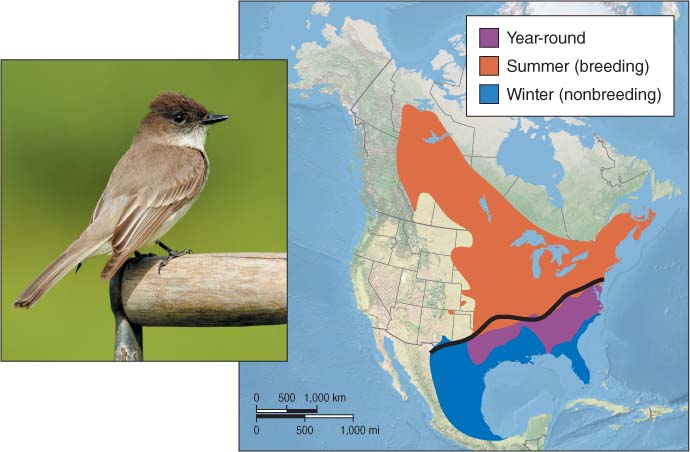
Many animals, such as amphibians, insects, and most fishes and reptiles, are poikilotherms (or cold-
Dormancy (a period of inactivity) is a common response of poikilotherms to low temperatures. Frogs and insects often hide from low winter temperatures by going underground into mud or burrows. Many endothermic animals enter a state of hibernation (winter dormancy) in a protected environment during the winter. During hibernation, their metabolic rate decreases to conserve energy. Endothermic animals that remain active in cold winter temperatures increase their metabolic rate and develop thick insulating layers of fat, fur, or feathers.
Many mammals living in cold environments have shorter appendages (such as legs, ears, and tails) than their counterparts in warm regions (Figure 7.11). This evolutionary pattern is called Allen’s rule.
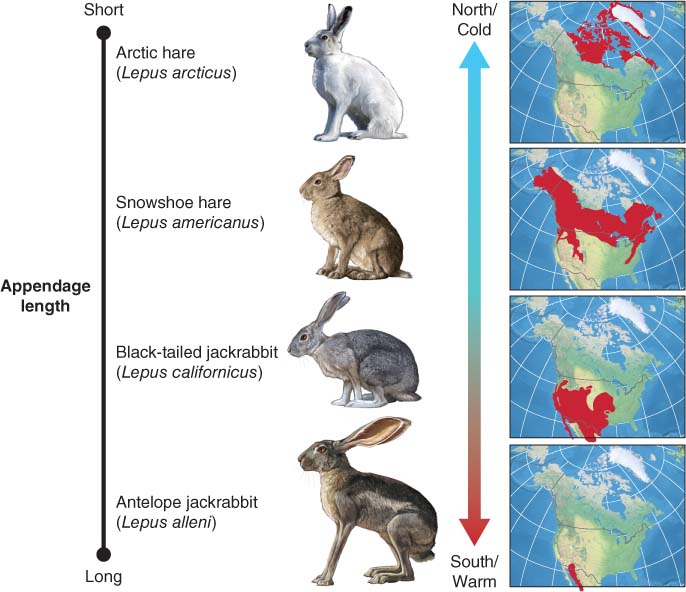
Water
All organisms need liquid water to carry out their metabolic processes. Plants can be grouped into three categories based on their water requirements:
Hydrophytes are plants that require submersion in water. A water lily is an example of a hydrophyte.
Mesophytes are plants that can tolerate a broad range of soil moistures, but are generally intolerant of prolonged drought. Most plants are mesophytes.
Xerophytes are plants that are adapted to environments with little available moisture. Cacti are xerophytes.
Plants have two main types of adaptations for coping with a lack of water: They escape water stress or they reduce water stress. Annual plants (plants that go to seed, then die, each year) escape water stress. Their seeds can remain dormant in the soil as a seed bank during long periods of drought, then germinate when conditions improve. Some seeds from the Sahara have germinated after 100 years of dormancy in the soil.
Question 7.4
Why do cacti have spines?
Cacti have spines to ward off animals trying to take their stores of water.
Perennial plants (plants that live longer than one year) must reduce water stress because they cannot escape it. The fishhook barrel cactus (Ferocactus wislizeni) is a xerophytic perennial that reduces water stress by a variety of adaptations (Figure 7.12). Other perennial plants have a long taproot that reaches moisture deep in the ground. Taproots of mesquite (Prosopis spp.) have been measured at more than 50 m (160 ft) long, although the aboveground portion of this desert plant is no more than 3 m (10 ft) tall. The baobabs of Africa and Madagascar reduce water stress by developing unusually thick trunks in which water is stored. A large baobab tree, like those shown in the opening photo for this chapter, can store up to 120,000 L (31,500 gal) of water.
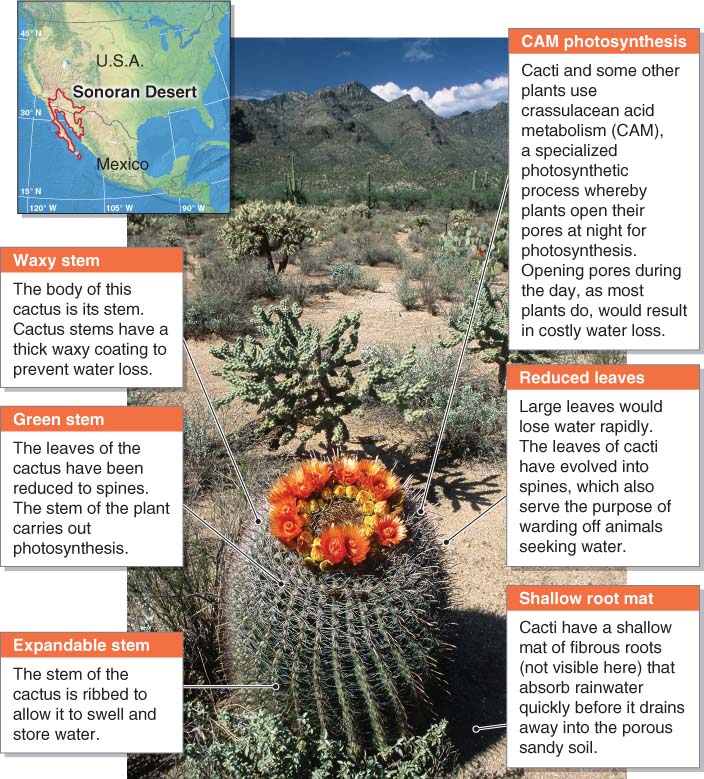
Like plants, animals either escape water stress or reduce water loss while they are active. Because animals are mobile, many of them escape dry conditions through migration. There are many examples of animals that undertake seasonal migrations in response to changes in water availability. Large herds of animals throughout sub-
Other animals have adaptations for reducing water stress. The kangaroo rats of the southwestern United States and northern Mexico (see Figure 7.5), for example, live in extremely arid desert climates. These animals never drink liquid water; instead, they derive water from the dry foods they eat. Water is produced as the compounds in their food react and combine with oxygen in their bodies. Their other water-
Biological Limiting Factors
Just as physical limiting factors such as light, temperature, and water influence the geographic range of a species, so too do the biological limiting factors of predation, competition, and mutualism.
Predation
Predation—the consumption of one organism by another—
predation
The consumption of one organism by another.
The geographic ranges of many species are determined by where their food sources live. Many insects have a narrow or specialized dietary range and eat only one or a few species of plants. The monarch butterfly, for example, can live only where its host plant, milkweed (Asclepias spp.), lives, as shown in Figure 7.13.
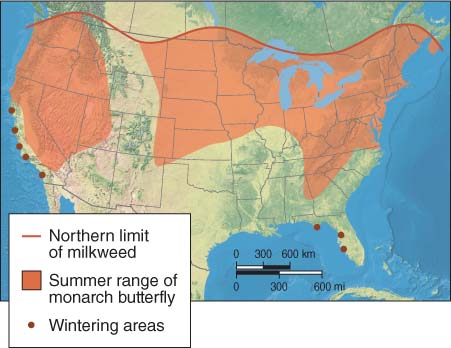
Most mammals are generalists and have a broad dietary range. Humans are a good example of a generalist mammal. Specialist mammals, with a narrow dietary range, are far less common. Two examples are the giant panda (Ailuropoda melanoleuca), which eats only bamboo, and the koala (Phascolarctos cinereus), which eats only leaves from eucalyptus trees.
Native predators are unlikely to hunt their prey to extinction. Instead, a predator may reduce the population of a prey species to the point that the predator must find a new source of food because that prey species becomes too difficult to find. This process is called prey switching. As a mountain lion reduces a deer population, for example, deer become too difficult for the mountain lion to find, and it will focus on another prey species. Or the mountain lion may simply hunt in a different area where deer are more abundant.
Non-
Question 7.5
How are wolves important to ecosystems?
Wolves function as keystone species in ecosystems, and many unrelated species benefit from their presence.
Native predators sometimes function as keystone species, species whose effects indirectly support many other species within an ecosystem. Keystone species play a crucial role in maintaining healthy ecosystems. The gray wolf, for example, is a keystone species in Yellowstone National Park, but no one understood its importance to other species until wolves, which had been eradicated from the park, were reintroduced in 1995 (Figure 7.14).
keystone species
A species whose effects support many other species within an ecosystem.
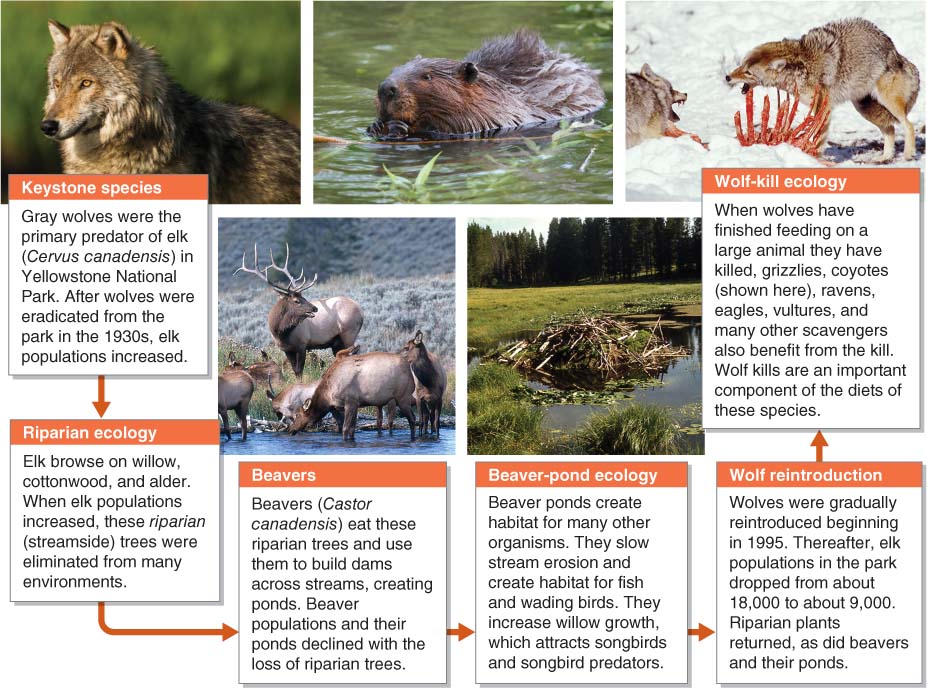
Competition
Competition is an interaction between organisms that require the same resources. A resource is anything that an organism needs, including food, territory, and mates. All organisms must compete with other organisms for resources. Competition between individuals of the same species is called intraspecific competition, and competition between different species is called interspecific competition.
competition
An interaction between organisms that require the same resources.
Plant species living in the same habitat compete with one another if their niches overlap. Hydrophytes do not compete with xerophytes because each occupies very different niches and habitats. However, xerophytes compete with other xerophytes when they occupy the same physical space. Plants compete in three main ways:
Plants shade one another as they compete for light.
Plants often employ chemicals that inhibit seed germination or growth in other plants. Such chemical competition is called allelopathy.
Plant roots compete for available nutrients and water beneath the ground.
The degree of competition among organisms depends on how similar their niches are. Individuals of the same species have identical niches and compete for exactly the same resources. Very different species, such as wolves and beavers, can share the same habitat, but they do not compete with one another for resources because they have different niches. Wolves and coyotes, on the other hand, live in the same habitat and have similar niches. As a result, they compete for many of the same resources. Wolves, for example, chase coyotes away from carcasses and are occasionally seen killing coyotes.
Animals may also compete indirectly. For example, the house cat (Felis catus) and the barn owl (Tyto alba) are competitors although they rarely interact directly. The barn owl eats small rodents and hunts on the wing, mostly at night. House cats hunt small rodents from the ground day and night. Although the two predators rarely meet, they are exploiting the same resource.
Mutualism
The old saying that nature is “red in tooth and claw” suggests that predation and competition are the most common types of biological interactions. Yet there are just as many examples of benign interactions between species. A relationship between two species that benefits both of them is called mutualism (Figure 7.15A). Mutualism can be a limiting factor because species are unlikely to reach their full reproductive potential without their mutualistic partners.
mutualism
A relationship between two species from which both species benefit.

Mutualism occurs in most ecological settings. In cases of obligate mutualism, neither party can survive without its partner. In facultative mutualism, both parties benefit from the relationship, but they do not need it to survive. In some cases of mutualism, one party is an obligate mutualist while the other is a facultative mutualist (Figure 7.15C).